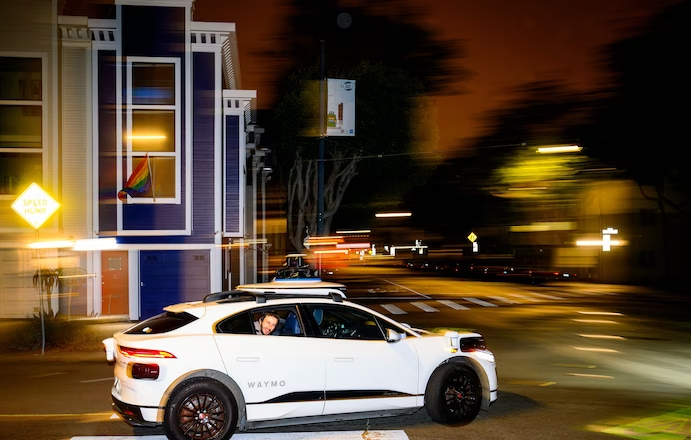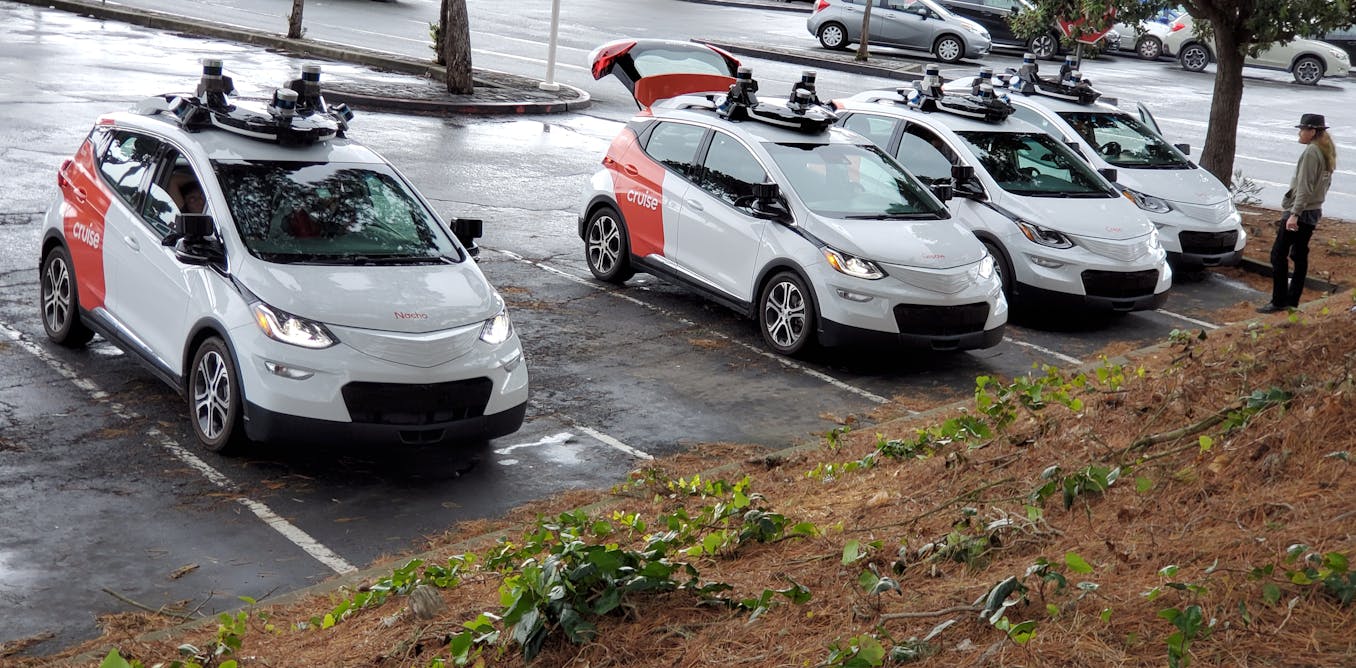California just opened the floodgates for self-driving cars
After a state regulatory board ruling, San Francisco will have 24/7 robotaxis on its streets. A Washington Post analysis shows how it’s a pivotal moment for the industry.
By Trisha Thadani and Jeremy B. Merrill
Updated August 10, 2023 at 10:06 p.m. EDT|Published August 10, 2023 at 9:15 p.m. EDT
SAN FRANCISCO — California regulators voted Thursday to allow self-driving car companies Waymo and Cruise to offer 24/7 paid taxi service in San Francisco, a major win for the industry that could pave the way for more widespread adoption of the technology.
Tech is not your friend. We are. Sign up for The Tech Friend newsletter.
Cars without drivers have become a common sight on San Francisco’s winding, hilly and often foggy streets. Thursday’s vote stripped most limitations on operating and charging for rides, essentially creating more ride-hailing services like Uber or Lyft — just without the drivers.
It’s a pivotal moment for the autonomous transportation industry, expanding one of the biggest test cases for a world in which many companies envision not needing drivers at all. For years, companies from Amazon to Google have experimented with self-driving vehicles, something that could prove incredibly disruptive to the labor economy if it ever materializes en masse.
In California alone, there are more than 40 companies — ranging from young start-ups to tech giants — that have permits to test their cars in San Francisco, according to the California Department of Motor Vehicles. According to a Washington Post analysis of the data, the companies collectively clock millions of miles on public roads every year — along with hundreds of mostly minor accidents.
California often serves as a “canary in the coal mine for the country and the developed world,” said David Zipper, Visiting Fellow at the Harvard Kennedy School’s Taubman Center for State and Local Government. “We’re talking about monumental impacts on how our streets work, environmental emissions, on sprawl, on equity. The potential impacts just can’t be overstated.”
The California Public Utilities Commission approved the permits for Waymo and Cruise on Thursday despite pushback from local leaders and many residents in San Francisco, who argue that the autonomous vehicles have caused chaos around the city — from traffic jams to disrupted emergency scenes. The 3-1 vote came after a seven-hour meeting in San Francisco, where hundreds of people came out both in support and against the proposals.
“I do believe in the potential of this technology to increase safety on the roadway,” said Commissioner John Reynolds, who is also a former managing counsel at Cruise. “Today is the first of many steps in bringing (autonomous vehicle) transportation services to Californians, and setting a successful and transparent model for other states to follow.”
Aaron Peskin, president of the San Francisco Board of Supervisors and a frequent critic of the self-driving cars, said he, Mayor London Breed and members of the city’s transportation agencies planned to meet after the vote to “discuss next steps.” He said it is “likely” the city would file for a rehearing, which would be a precursor to litigation against the commission.
“This is going to be an issue that San Francisco and cities and states around the country are going to grapple with for a long time to come,” he said. “So this is the beginning, not the end.”
Public data on California testing analyzed by The Post shows the sharp expansion in recent years: In 2020, 551 cars were tested over 1.8 million miles in California. By 2022, that grew to 1,051 cars tested over more than 4.7 million miles.
Google sister company Waymo and Cruise are the largest companies testing in the state by far, with hundreds of cars on the road in San Francisco at any given time. But there are other well-known names in the race, too: Apple, which has largely kept quiet on its self-driving car operation — internally dubbed Project Titan — had about 50 cars testing on public roads, according to 2022 data. Amazon’s Zoox has about 100 cars. A hodgepodge of largely start-ups comprise the rest.
(Amazon founder Jeff Bezos owns The Post. Interim CEO Patty Stonesifer sits on Amazon’s board.)
Despite the fervor around the industry, many experts caution that a more widespread Jetsons-like future is still probably years away. Already, companies like Uber and Tesla had predicted that they would be widespread by the mid-2020s, but the technology has failed to deliver. And while more than 40 companies have permits to test their technology in California, many still must have at least one human being supervising the driving. Several companies don’t appear to be actively testing the technology at all.
Still, California state Rep. Laura Friedman (D), who chairs the state’s Transportation Committee, said regulators are grappling with how to control this rapidly developing industry. She said Thursday’s vote should be a wake-up call that the state and federal government need to move faster.
“California is known for being a leader and innovator, and everyone wants that to continue,” she said. “At the same time, it’s very difficult for regulators to even know where to begin to regulate this. Is it around safety performance? Is it around the software? Is it around detection? We don’t know.”
As part of the conditions of operation in California, the companies are required to report certain information, such as mileage and collisions, to the National Highway Traffic Safety Administration, the California Department of Motor Vehicles and the CPUC. But critics say this data is unreliable and incomplete because the companies are not required to report a range of other incidents that affect the public — such as when a car veers into a bike or bus lane or stops short and disrupts traffic.
A driverless Waymo is stuck beside a downed tree after severe wind hit the Bay Area. (Video: Jessica Hilberman)
According to the data analyzed by The Post, there have been at least 236 collisions reported by companies with cars operating in fully autonomous mode in California since 2019 — most relatively minor. That does not include the many other examples of issues the cars have run into when they were operating in manual mode, or after the autonomous car was taken over by a human driver. The vast majority of collision reports are from Waymo and Cruise.
In statements, both Waymo and Cruise have stood by their safety records — saying their technology will ultimately lead to safer streets.
Just a few months after a Chinese start-up, Pony.ai, scored a permit to test its driverless cars on California’s roads in 2021, one of its cars rolled over a center divider in Fremont, Calif., and mangled a traffic sign. Regulators later revoked its permits. Today, according to the California DMV, the company is allowed to test so long as a human is present to take control when things go awry. According to public data, the company had 41 cars active in California in 2022.
Pony.ai did not respond to a request for comment.
That same year, an Apple car near its campus in Cupertino bumped into a curb at about 13 mph. No one was hurt, but it misaligned a wheel on the car. In two separate instances in May and June of this year, Amazon’s Zoox was involved in two minor crashes in San Francisco that caused injuries to the human drivers in the car.
Apple declined to comment. Amazon did not respond to a request for comment.
Philip Koopman, a Carnegie Mellon University professor who has conducted research on autonomous-vehicle safety for decades, said the self-driving car companies are under intense pressure to turn a profit and — in some cases — prove the business’s viability to shareholders. He worries about whether that fervor comes at the expense of public safety.
“Ultimately this industry is going to be about trust,” he said. “These car companies are using public resources to get free testing platforms.”
Since autonomous vehicles are regulated at the state level in California, local leaders have little say over how and where these cars operate in their cities.
In Los Angeles, Jarvis Murray, the county’s transportation administrator, said it is “untenable” to allow a new mobility service to expand without requiring companies to report more data and also give the cities more say over what is happening on their public roadways.
“As a city agency charged with protecting the safety of all road users, (Los Angeles Department of Transportation) does not believe enough data, studies, or emphasis has been placed on how this industry will affect a City’s safety goals or how AV passenger service will impact non-passengers,” Murray said in a letter to the CPUC.
Still, some officials report the technology is prompting minimal issues.
Mountain View Mayor Alison Hicks said she hasn’t been too bothered by the cars that are testing around her city. She said that’s probably because the roads in Mountain View are generally calm and wide, and many of the companies testing there still have safety drivers who can take control if needed.
What worries her the most is the massive impact that the cars could cause on society writ large — from issues around jobs, to implications for the climate and mass transportation. She said those are massive questions that leaders like her have yet to grapple with.
“Between AI and driverless vehicles, if they both come online at the same time, what happens to our workforce?” she said. “When new technology rolls out, safety is not the only issue. You have to look for a collection of issues.”
In an aerial view, Waymo autonomous vehicles sit parked in a staging area in San Francisco. (Justin Sullivan/Getty Images)
But in San Francisco, city officials say they are fed up with being a guinea pig for the industry.
In an attempt to halt Thursday’s vote, they wrote letters and spoke at hearings to bring attention to a string of incidents in recent months: A car stopping near the scene of a mass shooting, another getting tangled in caution tape and downed wires after a major storm and another blocking a firetruck from exiting a station for several minutes.
“I know this is the way the tech is going, and this is the way the industry is going, and that’s fine,” San Francisco Fire Chief Jeanine Nicholson previously told The Post. “But don’t shove it down our throats.”
There was also a more organic protest movement that stemmed from residents. In videos that went viral on Twitter, a group of people found that placing traffic cones on the nose of the vehicles disables them and causes them to stall.
Their goal: to highlight how easy it is to confuse the technology, and also pressure state regulators to halt the expansion of these cars on San Francisco’s streets.
Following the vote, Waymo said in a statement that it was “grateful for this vote of confidence” from the California regulators. Kyle Vogt, CEO of Cruise, said Thursday’s vote was a “huge milestone” for the autonomous vehicle industry.
“But even more importantly a signal to the country that (California) prioritizes progress over our tragic status quo,” he said. We “remain committed to collaborating closely with regulators to push toward this critical goal.”
But for Koopman, the Carnegie Mellon professor, Thursday’s decision was a discouraging sign of what’s to come for the industry.
“The regulators have been letting these guys do whatever they want thus far,” he said. “This yes vote means that if you create chaos on San Francisco’s streets, then there are no real consequences.”
https://www.washingtonpost.com/technology/2023/08/10/san-francisco-robotaxi-approved-waymo-cruise/?

